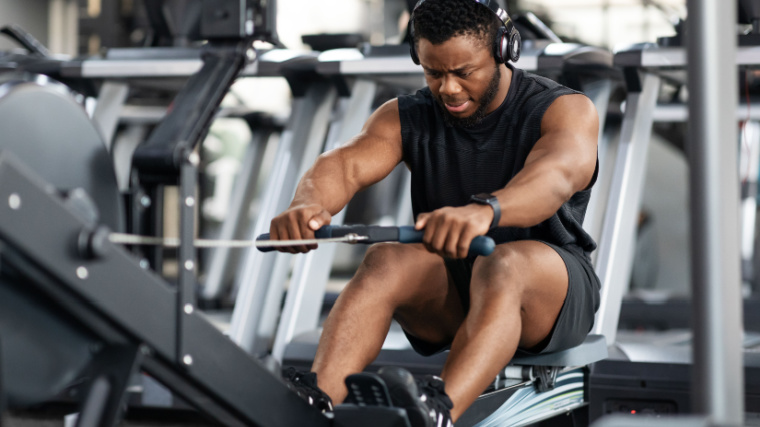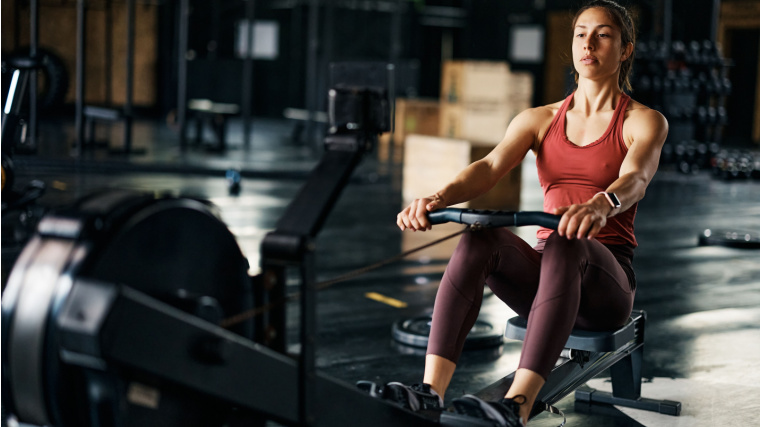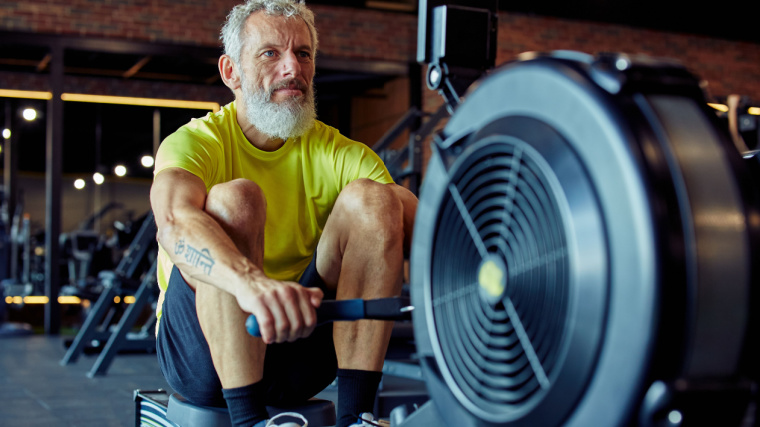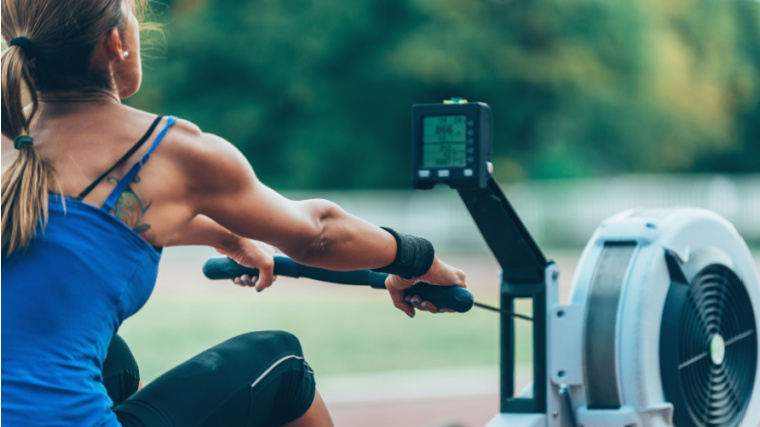
Steady-state cardio — plodding along at a consistent pace for the duration of a session — can have its place in a training program. However, high-intensity interval training (HIIT) can actually be a more efficient means to reach your fitness goals. And just like there are a variety of ways to build the ultimate physique, there are different machines you can rely upon to help get you there.
Although a treadmill offers the unique advantage of being able to train on an incline, it doesn’t give you a true full-body workout. Meanwhile, an elliptical machine may be a low-impact option for your joints, but that also comes at the expense of any muscle-building upside.
Luckily, there’s a piece of home gym equipment that provides the best of both worlds: the rower, sometimes called an erg or rowerg. In fact, you’ll be hard-pressed to find a machine that tests your muscular strength and endurance (and mental fortitude) quite like the erg.

Whether your primary goal is to burn body fat or boost your conditioning, these HIIT rowing workouts will get the job done. And if you’re just getting your feet wet with this type of training, there’s a beginner-friendly plan that will put you on the path to becoming more proficient and confident on the rowing machine.
HIIT Rowing Workouts
HIIT Rowing Workout for Fat Loss
A successful fat loss plan focuses on two factors: how you fuel up and how you put those resources to work. If your primary goal is to trim a few extra pounds off your frame, pairing interval training with a nutritional protocol that prioritizes protein and limits processed foods will provide the perfect stimulus to help accomplish that feat. Although this rowing workout may seem easy on the surface, you’ll quickly learn how challenging (and effective) time-specific training can be.
Tabata Intervals
There’s a reason the Tabata protocol remains one of the most popular styles of high-intensity interval training: It works. Designed in an easy-to-follow format, a workout consists of clearly defined intervals of max-effort exercise and complete rest. Typically, the high-intensity interval lasts for 20 seconds, forcing you to go all out for what sounds like a fairly reasonable amount of time.
However, the difficult part about Tabata-style training is that you only get a rest period of 10 seconds, or half the amount of the high-intensity interval. That back-and-forth battle usually wages on for eight cycles, adding up to a four-minute round. Most workouts run around 20 minutes, which includes a brief rest period of 1-2 minutes between each completed round.

Despite its short working intervals, Tabata delivers impressive results. It has been shown to be effective for improving both body fat composition and some cardiometabolic health outcomes in university female students. (1) Additionally, a 2020 study on the impact of Tabata training showed it was also effective in reducing body fat percentage and waist-to-hip ratio in overweight individuals. (2)
Ultimately, there’s no reason to make things complicated when it comes to your fat loss journey. This rowing workout relies upon a tried-and-true setup that should leave you feeling gassed by the end. It’s best to leave this for the end of a strength training session as a high-impact finisher, or perform it on a non-lifting day to reap the rewards of aerobic and anaerobic exercise.
Tabata Rowing Circuit
- How to Do it: Sit on the rowing machine seat and strap your feet in. Set the drag level between three and five. Grab the handle, maintain an upright posture, and simultaneously push with your legs while pulling with your upper body. Warm up at a comfortable pace for one minute before increasing to max effort for your first high-intensity interval.
- Programming: Perform 8-10 sets (one round) of 20 seconds of max-effort rowing followed by 10 seconds of rest. Repeat for three to five rounds, depending on your fitness level.
- Rest Time: Rest one to two minutes after each round.
HIIT Rowing Workout for Conditioning
Metabolic conditioning can have some crossover with fat loss training, but it also brings muscle-building benefits. And out of all the home gym equipment you should consider investing in, a rowing machine is a fantastic choice since it is capable of helping you achieve your dream physique in multiple ways.
This all-inclusive workout combines sprint intervals on the erg with various strength exercises for the ultimate conditioning session.
On/Off Circuit
Prepare to move around with this workout. At the same time, prepare to enjoy the conditioning rewards of mixing max-effort speed intervals on the rower with muscle-building exercises that will test your strength and stamina.

Rather than rowing for a specific time interval, your goal is to complete 250 meters as fast as possible. Then, you will go through a type of superset using resistance training exercises that target your chest, shoulders, triceps, quads, and glutes. Working hard on the rower will target your back muscles, so doubling up by targeting them with a strength-training exercise could cause excessive fatigue without added benefit.
This workout can serve as the baseline for your creative efforts. You can vary the routine in a variety of ways by increasing your target distance on the erg, increasing the time or load for the supplementary movements, or by choosing specific exercises based on your personal physique goals. Ultimately, the point is to push yourself through each phase, take a few minutes to recover, and find a way to keep going.
Rowing Speed Interval
- How to Do it: Sit on the rowing machine seat and strap your feet in. Set the drag level between five and seven for added resistance. Grab the handle, maintain an upright posture, and simultaneously push with your legs while pulling with your upper body. Warm up at a comfortable pace for one minute before increasing to max effort for your first high-intensity interval.
- Programming: Complete a 250-meter row as quickly as possible.
- Rest Time: No rest before moving to the next exercise.
Paused Push-Up
- How to Do it: Begin in the top of a traditional push-up position with your hands directly under your shoulders, your arms locked out, hips and legs straight, and toes on the ground. Lower yourself down until your chest is one to two inches from the floor and hold for two seconds. Engage your triceps and extend your arms to return to the starting point.
- Sets and Reps: Perform as many reps as possible in 30 seconds.
- Rest Time: No rest before moving to the next exercise.
Goblet Squat
- How to Do it: Stand with your feet shoulder-width apart and your toes slightly pointed out. Hold a kettlebell or dumbbell with both hands at chest-level (the “goblet” position), engaging your front deltoids (shoulders) to support the weight. While keeping your torso upright, push your hips back, bend your knees, and sit into a deep squat position. Drive through your heels and return to the starting position.
- Sets and Reps: Perform as many reps as possible in 30 seconds. Use a weight that allows at least 10 to 12 repetitions in the first round.
- Rest Time: No rest before moving to the next exercise.
Dumbbell Overhead Press
- How to Do it: Stand with your feet hip-width apart with a dumbbell in each hand at shoulder-level. Keep your wrists in a neutral position (palms facing each other) and push the weights toward the ceiling, fully extending your arms and locking out your triceps. Slowly lower the dumbbells back down to the starting position, maintaining full control on the eccentric (lowering) portion of the lift.
- Sets and Reps: Perform as many reps as possible in 30 seconds. Use a weight that allows at least 10 to 12 repetitions in the first round.
- Rest Time: Rest two to three minutes before repeating the first exercise.
HIIT Rowing Workout for Beginners
If you’re new to cardio training, or just new to the rowing machine, don’t be intimidated by the idea of an intense session on the erg. Instead, embrace the concept of pushing yourself for short spurts so you can earn some well-deserved rest. Plus, you can look forward to improving your technique with each and every stroke.
1:2 Work-to-Rest Intervals
A key difference between the previous fat-burning and conditioning workouts and this beginner-friendly plan is the amount of time you’ll spend working at a lower intensity. Instead of following a 1:1 work-to-rest ratio, beginners should opt for a 1:2 work-to-rest rate.
This structure is essentially the opposite of Tabata, which requires you to recover in half the amount of time as your high-intensity interval. Using a specific work/rest approach will give you the benefits of improving your VO2 max while also allowing a sufficient period for recuperation. (3)

You’ll be starting out with 20 seconds of work, followed by 40 seconds of rest. However, don’t be afraid to switch up that 1:2 ratio as you get more comfortable on the rower. Once you have completed this workout a few times, you can ramp up the difficulty by cutting the rest interval to 30 seconds. Then, trim it down another 5-10 seconds as you improve.
20 On/40 Off Rowing Circuit
- How to Do it: Sit on the rowing machine seat and strap your feet in. Set the drag level between three and five. Grab the handle, maintain an upright posture, and simultaneously push with your legs while pulling with your upper body. Warm up at a comfortable pace for one minute before increasing to near-max effort for your first high-intensity interval. Make sure to rest for double the amount of work-time for each cycle.
- Programming: Two sets of 8 rounds — each round requires 20 seconds of hard rowing, followed by 40 seconds of easy rowing.
- Rest Time: Rest for three minutes after completing the first round.
How to Warm-Up for a HIIT Rowing Workout
A structured warm-up isn’t just a means to break a sweat or get your head in the game prior to a workout. Besides being beneficial for performance, it’s also a proactive measure that can help prevent injuries. (4)
Because the erg requires you to recruit essentially every major muscle group, you need to prepare accordingly. Diving straight into any of the three HIIT workouts isn’t a sound strategy — especially if you’re hitting the gym after sitting at a desk for hours.
Set yourself up for success by completing this four-part warm-up which focuses on getting your shoulders, back, quads, and hamstrings ready for a rowing session that will leave you feeling accomplished from head to toe.
HIIT Rowing Workout Warm-Up
- Arm Circle: Stand with your feet about shoulder-width apart and your arms fully extended out to your sides so they are parallel with the floor. Keep your arms straight and begin making small circular motions in a forward direction. Progress to bigger circles for a wider range of motion. for 20 to 30 seconds. Then, perform the same movement in the opposite direction for another 20 to 30 seconds.
- Inch Worm: Stand tall with your feet about hip-width apart and your hands by your sides. Look down at the floor and start reaching your hands out in front of your feet as you allow your knees to bend slightly. Carefully walk your hands forward until they are directly under your shoulders and your body is parallel to the floor. From that full plank position, keep your legs straight and walk your hands back toward your feet. Brace your core and raise your upper body to return to the starting position. Perform 10 repetitions before moving to the next exercise.
- Paused Bodyweight Squat: Stand with your feet at a shoulder-width distance and your toes pointed slightly out. Brace your core, push your hips back, and slowly lower yourself down until your thighs are parallel to the floor. Hold for two seconds, then push through your heels and drive upward until you reach the starting position. Complete 15 to 20 full-depth squats before finishing up with the final part of the warm-up.
- Rowing Machine: Get on a rowing machine and set the damper to a low level (between one and four). Maintain a steady but comfortable pace for three to five minutes to prime your muscles and get in the flow for the high-intensity workout to follow.
Full-Body Benefits in Far Less Time
While you will most certainly work harder, you’ll also be working smarter with these HIIT rowing workouts. Ramping up the intensity means you won’t have to spend nearly as much time repeating the same motion until you’ve reached a state of boredom. Instead, efficient interval-style training will let you reap the full-body rewards of centering your next workout around the simple but incredibly effective rowing machine.
References
- Lu, Y., Wiltshire, H., Baker, J. S., Wang, Q., & Ying, S. (2023). The effect of Tabata-style functional high-intensity interval training on cardiometabolic health and physical activity in female university students. Frontiers in Physiology, 14. https://doi.org/10.3389/fphys.2023.1095315
- Domaradzki, J., Cichy, I., Rokita, A., & Popowczak, M. (2020). Effects of Tabata training during physical education classes on body composition, aerobic capacity, and anaerobic performance of under-, normal- and overweight adolescents. International Journal of Environmental Research and Public Health, 17(3), 876. https://doi.org/10.3390/ijerph17030876
- Helgerud, J., Høydal, K. L., Wang, E., Karlsen, T., Berg, P. R., Bjerkaas, M., Simonsen, T., Helgesen, C. S., Hjorth, N. L., Bach, R., & Hoff, J. (2007). Aerobic High-Intensity intervals improve VO2max more than moderate training. Medicine and Science in Sports and Exercise, 39(4), 665–671. https://doi.org/10.1249/mss.0b013e3180304570
- Ding, L., Luo, J., Smith, D. M., Mackey, M. J., Fu, H., Davis, M. M., & Hu, Y. (2022). Effectiveness of Warm-Up Intervention Programs to Prevent Sports Injuries among Children and Adolescents: A Systematic Review and Meta-Analysis. International Journal of Environmental Research and Public Health, 19(10), 6336. https://doi.org/10.3390/ijerph19106336
Featured Image: Microgen / Shutterstock






